by Todd Rutherford
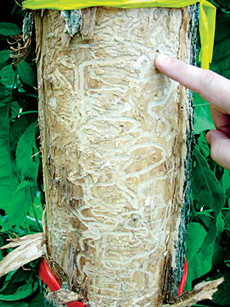
Green Ash tree killed by Emerald Ash Borer
2013 brought tragic news to urban tree enthusiasts in Colorado. In September 2013 the emerald ash borer was found in Boulder County. This find means that thousands of trees along Colorado’s Front Range could be decimated by this pest. And as Colorado State University Professor of Entomology Whitney Cranshaw tells us, the spread of the emerald ash borer (EAB) is dependent upon human activity. It is likely that EAB came to the United States via humans transporting contaminated wood crates from Asia, and it probably reached Colorado through contaminated firewood.
The emerald ash borer, Agrilus planipennis, is a beetle native to Asia. It is small, about the size of a grain of rice. Being a non-native insect in North America, it has no predators to keep its population in check. And unlike the Ash trees in Asia, our native Ash trees don’t possess the natural insecticides that control EAB. Adult borers eat leaves of Ash trees, then mate and lay eggs in crevices in the bark. The eggs hatch, releasing larvae which burrow beneath the bark, which disrupts the trees nutrient and water supplying layers. The tree becomes riddled with tunnels the larvae leave behind. The larvae then hatch in spring, burrowing their way to the surface, where they repeat the cycle of feeding on the leaves, breeding and laying eggs of new generation. They kill the canopy of the tree, limb by limb, with the entire tree dead in 3-5 years.
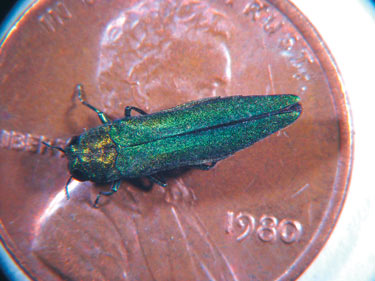
Adult EAB on a penny.
Colorado’s department of Agriculture estimates that there are 1.45 million ash trees in just the Denver Metro area alone. The costs to spray so many trees will quickly mount.
Tree and insect experts agree that there is no point in spraying your Ash tree unless the tree is currently infested. “Since most EAB treatments provide control for one year or, at most, two years following application there is no benefit in treating a tree prior to when EAB is present”, Cranshaw writes in a recent report from Colorado State University.
In other words there is no treatment that will stop the EAB from attacking your Ash tree. Spraying before the tree is infested only wastes money and needlessly adds dangerous chemicals to the environment. In fact, many entomologists warn that even spraying an infested tree may have lethal impacts on beneficial insects such as bees and butterflies, and won’t completely rid your tree of EAB, and would probably only buy you a few extra years of life of an infested Ash tree.
If we take a serious look at the situation, spraying at all is mostly a futile and dangerous endeavor. Spraying gives tree care companies extra income but endangers the life of beneficial insects, could possibly have harmful effects on people and is very unlikely to ultimately save your Ash tree. As CSU’s Cranshaw has said, he expects in 5-10 years all Ash trees in the Metro Denver area to be infested by EAB. Furthermore, Cranshaw writes: “Once established at a location emerald ash borer can be expected to survive in the area as long as any ash trees remain. Therefore some management of emerald ash borer will be required for as long as one wishes to maintain the tree”. It is our opinion that a better strategy to dealing with EAB is planning for the eventual replacement of your Ash tree, rather than treating your ash tree with toxic chemicals, year after year.
What can we do to slow the spread of EAB to the rest of Colorado?
1.) Do not transport any ash wood in or out of your area.
2.) Do not plant more Ash trees in Colorado.
If you have an Ash tree, you really should consider planting a replacement tree now. If you are unsure about what type of tree would be a good alternative to Ash, contact your local nursery, arborist, or contact us and we can help you with that decision.
This is the official blog of Outdoor Design Group, Colorado Landscape Architects. For more information about our business and our services, click here.
Related Posts:
by Matt Corrion
Despite the recent rain across Colorado, much of the state remains in a drought.
The watering restrictions that Denver Water put in place for this year remain in place, having gone into effect on April 1st.
You may be aware that watering restrictions mean you can only water two days per week, but how long should you run your lawn sprinklers on those days? Denver Water recently released this chart, which includes recommended watering times for different types of spray irrigation. Note that due to the drought, these watering times have been reduced from their standard recommendations.
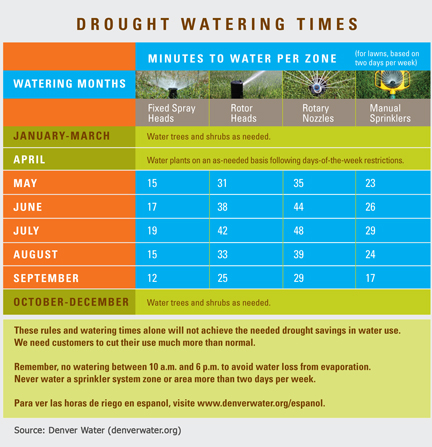
This is the official blog of Outdoor Design Group, Colorado Landscape Architects. For more information about our business and our services, click here.
Related Posts:
by Matt Corrion
The drought of 2002 was very hard on landscaping in Colorado. Plants and lawns were stressed by the hot and dry conditions, and mandatory watering restrictions were put in place across the state. Many of us in the landscaping industry vividly remember these hard times.
Well, the drought is back. Today the USDA predicted a huge drop in corn yields, the latest is a long summer of bad drought news. Below are maps issued by the U.S. Drought Monitor from back in July of 2002 and from July of 2012. As you can see, there are many similarities and much of Colorado is once again in an “extreme drought” situation.
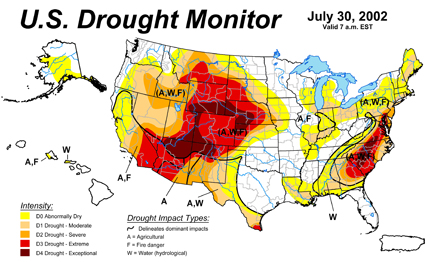
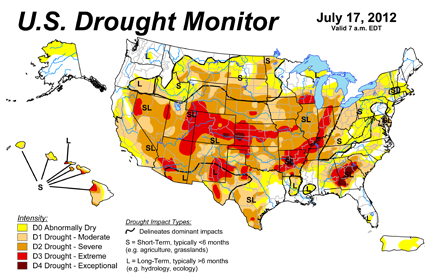
Outlook Does Not Look Good
According to the National Weather Service Climate Prediction Center, the U.S. Seasonal Drought Outlook doe not look promising, although some improvement may occur in southwestern Colorado:
Dryness and drought, exacerbated by above-normal temperatures, have been increasing both in extent and intensity across much of the central and northern U.S. Based upon the July 24 U.S. Drought Monitor, almost 64 percent of the contiguous U.S. was in drought (D1-D4), the highest such value for the U.S. Drought Monitor since its inception in 2000. The last time the lower 48 States had a comparable area of drought (based upon the monthly Palmer Drought Index) was in 1956, according to NCDC.
Across the Southwest, the odds favor an active (wet) southwest monsoon in both the 1- and 3-month precipitation outlooks. As a result, improvement is anticipated across much of Arizona, southern Utah, and southwestern Colorado as the summer monsoon continues.
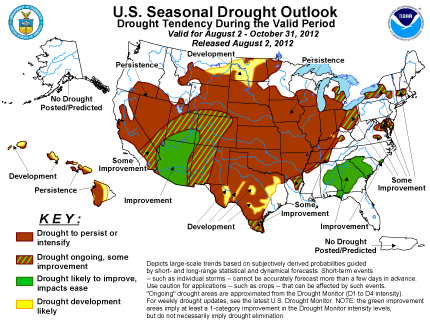
What Does this Mean for Landscaping in Colorado?
As these maps illustrate, the drought conditions that plagued Colorado in 2002 have resurfaced, and most long-term indicators point to continued drought. The good new is that there are some relatively simple changes and considerations for your landscaping to make it resilient to these conditions.
Some of the lessons we have learned and changes that can be made to your landscaping to better withstand drought include:
- Design new landscapes to be more drought tolerant in the first place. Take a more thoughtful professional approach to your landscape design and consider long term maintenance costs as well as installation costs. Consider hiring a landscape architect or design professional.
- Install the latest irrigation technologies to eliminate wasted water: smart weather based controllers, rain sensors, efficient spray nozzles and drip irrigation, to name a few.
- If lawn areas are not used for foot traffic, and are simply for aesthetics, convert these areas to masses of low growing shrubs, groundcovers, or native grass. You can achieve a similar look with plant massings at the groundplane while reducing water needs and maintenance requirements significantly.
- If you have an older irrigation system, consider having a professional do a water audit, and upgrade old nozzles to new, more efficient ones. If you are stuck with a landscape that requires a lot of water (such as large areas of bluegrass with spray irrigation) you should at least fine tune your sprinkler system. This approach is kind of like putting lipstick on a pig (since your landscape will still “require” the same amount of water to be healthy), however there are some new irrigation nozzles such as the Hunter MP Rotator that can be much more efficient at delivering water where it’s needed. At the very least, these upgrades could be a stopgap measure until the landscape can be renovated.
- Remove large areas of high water use bluegrass and lawns, and replace with native or drought tolerant plantings. A renovation of this sort will make the biggest impact by far. You can covert your landscaping from one that requires a lot of water to remain healthy, to one that requires minimal water and still looks beautiful.
So there you have it. The drought is here to stay. Colorado is a semi-arid climate that will remain dry. While tweaks and minor changes to irrigation systems can provide temporary relief, landscaping that requires a lot of water to stay healthy will always struggle in Colorado and the best approach is to install drought tolerant landscaping from the start, or renovate your landscaping to plantings that require less water.
This is the official blog of Outdoor Design Group, Colorado Landscape Architects. For more information about our business and our services, click here.
Related Posts:
by Matt Corrion
On March 15, 2012, facilities across the United States must comply with the revised ADA (Americans with Disabilities Act) design standards adopted in the 2010 Standards for Accessible  Design.
Design.
The 2010 Standards set minimum requirements for newly designed and constructed or altered State or local government facilities, public accommodations, and commercial facilities to be readily accessible to and usable by individuals with disabilities.
I have reviewed the new standards, and they are pretty extensive. Property owners and designers should be aware of some of the changes that will be required when constructing or altering a facility.
The provision requiring accessible means of entry/exit for swimming pools has gained a lot of attention. On March 15th, the US Attorney General signed an extension of 60 days for this particular provision, while also opening up a public comment period.
The swimming pool provision, along with other key new provisions, as taken from the ADA website, include:
2. Recreational Boating Facilities (Sections 235, 1003)
If boat slips are provided at a boating facility, the minimum number that must be accessible depends upon the size of the facility. Accessible boat slips must be dispersed throughout the various types of boat slips.
Where boarding piers are provided at boat launch ramps, at least 5% (but no fewer than one) must be accessible. Gangways that are part of a required accessible route are to be accessible, subject to certain enumerated exceptions.
4. Fishing Piers and Platforms (Sections 237, 1005)
Newly designed, newly constructed, or altered fishing piers must provide accessible routes, subject to the same exceptions permitted for gangways. At least 25% of guardrails or handrails must be no higher than 34 inches and must be dispersed. Clear floor or ground space must be provided at each accessible railing, and turning space must be provided on the pier.
5. Golf Facilities (Sections 238, 1006)
Newly constructed and altered golf facilities must have either an accessible route or golf car passages with a minimum width of 48 inches connecting accessible elements and spaces within the boundary of the golf course. An accessible route must be provided to the golf car rental area, bag drop-off areas, and other elements that are outside the boundary of the golf course. One or two teeing grounds (depending on the total number provided) per hole must be accessible.
If weather shelters are provided, a golf car must be able to enter and exit the shelters. Certain percentages of practice teeing grounds, practice teeing stations at driving ranges, and putting greens must be accessible.
6. Miniature Golf (Sections 239, 1007)
At least fifty percent of all holes on a miniature golf course must be accessible. These accessible holes must be consecutive, and they must be on an accessible route. The last accessible hole must be on an accessible route that connects to the course entrance or exit without going back through other holes.
7. Play Areas (Sections 240, 1008)
Play areas designed, constructed, and altered for children ages two and over in a variety of settings, including parks, schools, childcare facilities, and shopping centers, are covered.
Accessible ground and elevated play components, accessible routes, ramps and transfer systems (typically a platform or transfer steps), and accessible ground surfaces must be provided.
8. Swimming Pools, Wading Pools, and Spas (Sections 242, 1009)
Accessible means of entry/exit are required for swimming pools. Such accessible means of entry include a pool lift or sloped entry, and either a transfer wall, transfer system, or pool stairs. Wading pools must provide a sloped entry, and spas must provide a pool lift, transfer wall, or transfer system. Wave action pools, leisure rivers, and sand bottom pools where user access is limited to one area shall not be required to provide more than one accessible means of entry, either a pool lift, sloped entry, or a transfer system.
This is the official blog of Outdoor Design Group, Colorado Landscape Architects. For more information about our business and our services, click here.
Related Posts:
by Matt Corrion
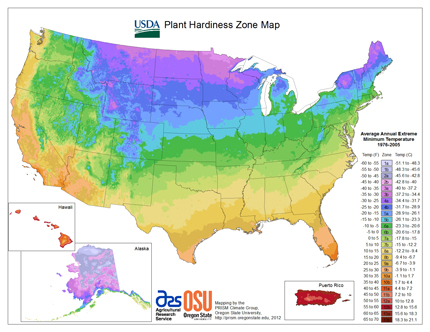
On January 25th, the U.S. Department of Agriculture (USDA) released an updated version of their Plant Hardiness Zone Map. Here are some excerpts from the USDA website, where you can also view and download the new maps:
The 2012 USDA Plant Hardiness Zone Map is the standard by which gardeners and growers can determine which plants are most likely to thrive at a location. The map is based on the average annual minimum winter temperature, divided into 10-degree F zones.
For the first time, the map is available as an interactive GIS-based map, for which a broadband Internet connection is recommended, and as static images for those with slower Internet access. Users may also simply type in a ZIP Code and find the hardiness zone for that area.
No posters of the USDA Plant Hardiness Zone Map have been printed. But state, regional, and national images of the map can be downloaded and printed in a variety of sizes and resolutions.
My thoughts: It is kind of surprising that the maps have not been updated since 1990.
You can enter your zip code, search by state, or simply click on your state on the national map to get a new state map.
Colorado, like most places, got a little warmer. Now Zone 3 only includes areas at high elevations. The foothills are a mix of Zone 4 and 5, and the urban “heat island effect” is taken into consideration with Denver in Zone 6. What changes are you seeing for your area?
This is the official blog of Outdoor Design Group, Colorado Landscape Architects. For more information about our business and our services, click here.
Related Posts:






 Design.
Design.